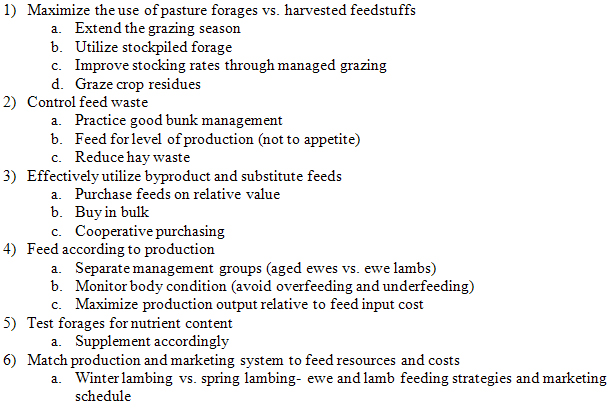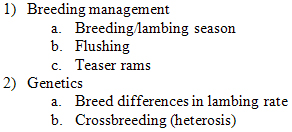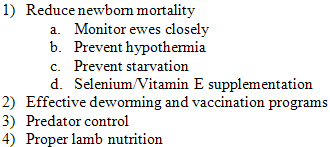
You've reached the Virginia Cooperative Extension Newsletter Archive. These files cover more than ten years of newsletters posted on our old website (through April/May 2009), and are provided for historical purposes only. As such, they may contain out-of-date references and broken links.
To see our latest newsletters and current information, visit our website at http://www.ext.vt.edu/news/.
Newsletter Archive index: http://sites.ext.vt.edu/newsletter-archive/

Management Components for Profitable Sheep Enterprises
Livestock Update, February 2008
Dr. Scott P. Greiner, Ph.D., Extension Animal Scientist, VA Tech
![]()
Profitability for any sheep production enterprise is affected by a large number of factors. These factors can generally be categorized into two components: 1) strategies to decrease costs of production (expenses), and 2) strategies to increase income. There are a large number of practices and management factors, as well as many external factors, which affect profitability. Each sheep enterprise is unique, as resources (capital, labor, management) and their limitations are specific to an individual operation. The key to enhancing profitability is identifying and focusing management efforts on critical control points which will enhance the bottom line.
Decision-Making Tools
A fundamental component of enhancing profitability is making sound decisions, and having the ability to assess opportunities for cost control or revenue enhancement. This ability is dependent on flock financial and production data. The ability to make sound decisions is dependent on accurate records for income sources and costs of production, as well as basic production parameters for the flock. Essential records include both usage and costs associated with pasture and feed, health, breeding, facilities, and marketing. Essential production records include inventory, pregnancy and lambing rates, death loss, and marketing weights along with detailed receipts for income generated. There are a number of tools available to assist producers in collecting and organizing this necessary information, ranging from complex computer record-keeping programs to pocket notebooks. Virginia Cooperative Extension has available sheep enterprise budgets, which can be accessed at http://www.ext.vt.edu/departments/agecon/spreadsheets/livestock/sheep.html. This budget can be utilized as a guideline to the collection and assembly of the necessary information to make decisions regarding production and financial parameters which will influence returns.
Cost Control
Feed expenses for the flock represent the single largest cash cost of the sheep production enterprise. Table 1 provides a summary of the financial analysis from the Pipestone Lamb and Wool Enterprise Summary. This summary is from flocks in the upper Midwest, and represents the average of financial data collected from 2002-2005.
Table 1. Financial Analysis- Pipestone Lamb and Wool Program
|
2002-2005 4 Yr. Avg. |
Feed- Breeding Flock |
$44.04 |
Feed- Lambs |
$35.91 |
Other Direct Cash Expenses |
$36.57 |
Total |
$116.52 |
This summary shows that feed costs represent a large portion of the cash costs associated with the sheep enterprise (69% of total cash costs). Annual cash costs per ewe averaged $80.61 (lamb feed costs not included). While production systems may differ for flocks in Virginia, the proportion of total costs attributed to feeding the ewe flock remains the single largest cash expense. Given this fact, management practices which reduce and control feed costs favorable impact returns.
There are several considerations to evaluate regarding control and reduction of feed costs. Producers may consider the following strategies:

In the context of evaluating feed costs, it is imperative to keep in mind that level of production has a direct relationship with feed inputs. As an example, nutritional regime impacts milk production of the ewe and directly impacts lamb growth. For production systems which rely primarily on harvested feedstuffs (winter lambing), feeding strategies which optimize production are warranted. Conversely, it makes little economic sense to aggressively feed spring-lambing ewes which will nurse lambs while spring/summer grazing (lambs to be marketed in the fall/winter). The return on investment for early feeding of ewes under this production system is low, as rapid early growth is not necessary or economically warranted. Simply put, feeding strategies must be compatible with desired level of performance as well as the production system. Producers which deliver the proper nutrition in a cost-effective manner will be more profitable within a given system. Overfeeding is costly, and “starving for profit” is simply not achievable as production will negatively impacted.
Enhanced Revenue
The other avenue through which profitability can be enhanced is through increased revenue. In fact, most advances in technology and management are designed to enhance outputs. For the sheep enterprise, enhanced revenue can largely be realized through mechanisms which increase total income per ewe. Total income per ewe can be enhanced through marketing more pounds of lamb per ewe (increased production), increasing the value of lambs marketed (higher prices), or a combination of the two.
There are many opportunities whereby levels of production may be enhanced. Management and genetics both play an important role. This is illustrated by the impact of percent lamb crop as well as lamb survivability on potential returns. Both of these traits have a direct effect on pounds of lamb marketed per ewe exposed. Table 2 illustrates the impact of lambing rate and survivability on returns as estimated from the VCE Enterprise Budget.
Table 2. Impact of Lambing Rate and Survivability on Estimated Returns
|
175% Lamb Crop |
175% Lamb Crop |
190% Lamb Crop |
190% Lamb Crop |
Lambs Marketed/Retained per Ewea |
1.40 |
1.58 |
1.52 |
1.71 |
Value of Lambs Marketed per Ewe |
$137 |
$154 |
$148 |
$167 |
Feed Cost per Ewe |
$93 |
$97 |
$96 |
$101 |
Total Cash Cost per Ewe |
$121 |
$127 |
$126 |
$132 |
Return per Eweb |
$22 |
$35 |
$31 |
$45 |
aTotal lambs marketed + lambs retained)/Ewes Exposed
bReturn to equity, management, and labor.
This example provides evidence that the number of lambs marketed per ewe favorably impacts profitability. Therefore strategies which optimize the number of lambs born and reduce death loss are favorable. There are a number of factors which influence the number of lambs born, including:

As with any management consideration, the potential impact of a practice must be evaluated relative to its potential impact on returns. For example, it has been well established that flushing is more advantageous for ewes with moderate body condition compared to fat ewes. Flushing fat ewes is an expense that will return little on the feed and labor expense invested.
For many producers, opportunities exist to increase the percentage of lamb crop marketed. A primary inefficiency in the sheep industry is lamb mortality from birth to weaning, and most lamb death loss occurs in the first few days after birth. Recommended practices to reducing death losses from birth to market include:

Adding value to the lamb crop through targeted marketing strategies also is a method to enhance revenues. Close attention to market price trends influenced by season, religious holidays, and ethnic demand provide opportunity to capture additional dollars. Other options such as on-farm sales, direct marketing, and breeding stock should also be considered as means to add value to the lamb crop.
Summary
Defining the key components related to profitability for any sheep enterprise is dependent on the ability to measure with certainty the costs associated with production, and levels of performance. Upon establishing these parameters, attention can be given to the primary cost components and income generators for the flock. Focus should be directed to the large expense items, which contribute the most to total enterprise cash outlays. Concurrently, strategies which favorably impact gross revenue should be evaluated.